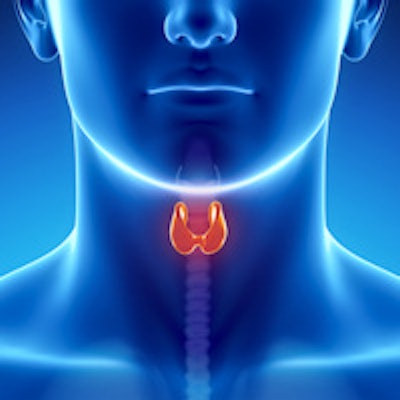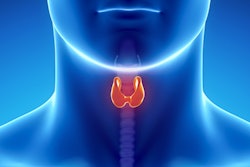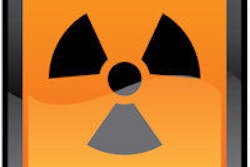
Yes, surveillance imaging can identify the recurrence of thyroid cancer in patients who have received treatment. But that doesn't mean the scans will affect patient survival, according to a large retrospective study published online July 21 in BMJ.
 Dr. Megan Haymart of the University of Michigan Comprehensive Cancer Center.
Dr. Megan Haymart of the University of Michigan Comprehensive Cancer Center.A research team from the University of Michigan Comprehensive Cancer Center reviewed more than 28,000 patients with the most common types of thyroid cancer in the Surveillance, Epidemiology, and End-Results (SEER) Medicare database and found that recurrence rates for incident cancer, imaging, and treatment all increased over a 13-year period. While the researchers determined that imaging was associated with treatment for recurrence, they also discovered that imaging -- with the notable exception of radioiodine scans -- did not yield a statistically significant change in thyroid cancer death rates.
"More imaging does not necessarily equal better care," senior author Dr. Megan Haymart told AuntMinnie.com. "Although there is a role for imaging after primary treatment of thyroid cancer, it should be tailored to patient risk."
Growing incidence
Thyroid cancer is the eighth most common cancer in the U.S., and diagnosis rates for the cancer have been growing over the past three decades. The majority of this increased incidence is secondary to detection of more low-risk disease, Haymart said. The researchers had found a paradoxical rise in imaging after primary treatment of thyroid cancer, and they subsequently wanted to understand the implications of why more imaging was being performed (BMJ, July 21, 2016).
 Mousumi Banerjee, PhD, of the University of Michigan Comprehensive Cancer Center.
Mousumi Banerjee, PhD, of the University of Michigan Comprehensive Cancer Center."We undertook this study to investigate the impact of post-treatment surveillance imaging on thyroid cancer outcomes, that is, with this increased use of imaging are we catching more recurrences, and ultimately are we saving lives?" said lead author Mousumi Banerjee, PhD.
Using the SEER database, the group reviewed all 28,220 patients who had been diagnosed with differentiated thyroid cancer -- encompassing papillary, follicular, and Hürthle cell tumor histology -- between 1998 and 2011. These patients were followed up to 2013, with a median follow-up period of 69 months, according to the group. The researchers used Medicare current procedural terminology (CPT) codes to identify both the type of imaging used in each patient and any treatment for recurrence. They also reviewed the SEER mortality data.
Of the study cohort, 64.1% of the patients had localized disease, with 31.1% of them having tumors that were less than 1.0 cm in diameter. Most (86.9%) had papillary thyroid cancer, and 70.3% were women. There were 1,155 (4.1%) deaths from thyroid cancer over the study period.
The researchers found substantial imaging utilization after treatment:
- At least one neck ultrasound study: 56.7%
- Radioiodine scan: 23.9%
- PET exam: 14.9%
The researchers also calculated rate ratios to determine if there was an increase in incidence rates from 1998 to 2011 for variables such as incident cancer, imaging, treatment of recurrence, and disease-specific death rates. A rate ratio higher than 1 reflects an increase from 1998 to 2011, while a rate ratio less than 1 indicates a decrease:
- Imaging -- rate ratio: 1.13 (95% confidence interval [CI]: 1.12-1.13)
- Incident cancer -- rate ratio: 1.05 (95% CI: 1.05-1.06)
- Treatment of recurrence -- rate ratio: 1.01 (95% CI: 1.01-1.02)
- Disease-specific death -- rate ratio: 0.98 (95% CI: 0.96 to 1.00)
While the increases in imaging, incident cancer, and treatment of recurrence were all statistically significant, the change in death rate was not, according to the researchers.
After performing additional statistical adjustments to address potential differences between the imaged and nonimaged groups, the team found that the use of ultrasound, radioiodine scans, and PET were all associated with treatment for recurrence, such as additional surgery, additional radioactive iodine treatment, and radiation therapy.
Impact on patient survival
However, only radioiodine scans were associated with improved disease-specific survival. These associations were calculated as adjusted hazard ratios; a ratio lower than 1 indicates a higher probability of survival, while a ratio higher than 1 indicates a lower probability.
- Radioiodine scan -- adjusted hazard ratio: 0.70 (95% CI: 0.60 to 0.82)
- PET -- adjusted hazard ratio: 0.91 (95% CI: 0.77 to 1.07)
- Neck ultrasound -- adjusted hazard ratio: 1.14 (95% CI: 0.98 to 1.27)
The radioiodine scan was associated with a statistically significant improvement in disease-specific survival rates (p < 0.001), while PET (p = 0.25) and neck ultrasound (p = 0.087) did not have a statistically significant association with survival rates.
The researchers identified two plausible reasons for the significant improvement in disease-specific survival in patients who receive radioactive iodine scans. First, radioactive iodine scans should only be given to patients if they have a history of iodine-avid disease and have biochemical evidence of recurrence.
"These patients have a need to know whether structural iodine-avid recurrence exists, and therefore warrant treatment with radioactive iodine," the authors wrote. "In patients with iodine-avid disease, especially those with distant metastases that are not amendable to surgery, radioactive iodine is often effective treatment."
What's more, iodine avidity generally suggests a slowly growing disease and a better prognosis, according to the group.
PET has increasingly been used in patients with thyroid cancer since 2004, but prior research concluded that patient management was only changed 30% of the time after a PET scan, according to the group. As a result, the University of Michigan team believes that PET's role in thyroid cancer surveillance needs to be better defined.
"Although costly imaging such as PET scan is appropriate for select patients, there are a large number of patients receiving imaging for whom survival may not be affected," Banerjee said.
While neck ultrasound is the optimal imaging modality for finding regional recurrence of thyroid cancer, the prognostic significance of regional recurrence with respect to survival is debatable, the authors noted.
"Therefore, it is plausible that greater use of ultrasound imaging is detecting more regional recurrence, but that this regional recurrence might not always indicate worse survival," they wrote.
Reassessing thyroid cancer surveillance
The study provides a foundation for reassessing thyroid cancer surveillance patterns and decreasing unnecessary imaging, Haymart said.
"However, additional work is needed," she said. "Through future studies, we hope to understand the role of the patient and the physician in determining the surveillance plan after primary treatment of thyroid cancer."
Indeed, the study will be the springboard for future cost-effectiveness studies, randomized controlled trials, and studies that assess the roles of the patient and physician in selecting the best surveillance plan, Banerjee said.



















